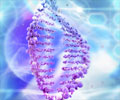Even though one might think that the brains of people who develop Alzheimer's disease (AD) possess building blocks of the disease absent in healthy brains, but for most sufferers, this is not true.

For researchers like Subhojit Roy, MD, PhD, associate professor in the Departments of Pathology and Neurosciences at the University of California, San Diego School of Medicine, these facts produce a singular question: Why don't we all get Alzheimer's disease?
In a paper published in the August 7 issue of the journal Neuron, Roy and colleagues offer an explanation – a trick of nature that, in most people, maintains critical separation between a protein and an enzyme that, when combined, trigger the progressive cell degeneration and death characteristic of AD.
"It's like physically separating gunpowder and match so that the inevitable explosion is avoided," said principal investigator Roy, a cell biologist and neuropathologist in the Shiley-Marcos Alzheimer's Disease Research Center at UC San Diego. "Knowing how the gunpowder and match are separated may give us new insights into possibly stopping the disease."
The severity of AD is measured in the loss of functioning neurons. In pathological terms, there are two tell-tale signs of AD: clumps of a protein called beta-amyloid "plaques" that accumulate outside neurons and threads or "tangles" of another protein, called tau, found inside neurons. Most neuroscientists believe AD is caused by the accumulating assemblies of beta-amyloid protein triggering a sequence of events that leads to impaired cell function and death. This so-called "amyloid cascade hypothesis" puts beta-amyloid protein at the center of AD pathology.
Creating beta-amyloid requires the convergence of a protein called amyloid precursor protein (APP) and an enzyme that cleaves APP into smaller toxic fragments called beta-secretase or BACE.
Advertisement
But that doesn't happen. Using cultured hippocampal neurons and tissue from human and mouse brains, Roy – along with first author Utpal Das, a postdoctoral fellow in Roy's lab, and colleagues – discovered that healthy brain cells largely segregate APP and BACE-1 into distinct compartments as soon as they are manufactured, ensuring the two proteins do not have much contact with each other.
Advertisement
The scientists also found that the conditions promoting greater production of beta-amyloid protein boost the convergence of APP and BACE. Specifically, an increase in neuronal electrical activity – known to increase the production of beta-amyloid – also led to an increase in APP-BACE convergence. Post-mortem examinations of AD patients revealed increased physical proximity of the proteins as well, adding support to the pathophysiological significance of this phenomenon in human disease.
Das said the findings are fundamentally important because they elucidate some of the earliest molecular events triggering AD and show how a healthy brain naturally avoids them. In clinical terms, they point to a possible new avenue for ultimately treating or even preventing the disease.
"An exciting aspect is that we can perhaps screen for molecules that can physically keep APP and BACE-1 apart," said Das. "It's a somewhat unconventional approach."
Source-Eurekalert












